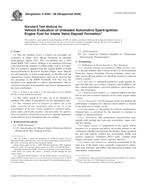Potrebujeme váš súhlas na využitie jednotlivých dát, aby sa vám okrem iného mohli ukazovať informácie týkajúce sa vašich záujmov. Súhlas udelíte kliknutím na tlačidlo „OK“.
ASTM D5500-98(2008)
Standard Test Method for Vehicle Evaluation of Unleaded Automotive Spark-Ignition Engine Fuel for Intake Valve Deposit Formation
Automaticky preložený názov:
Štandardné testovacie metódy pre hodnotenie vozidiel bezolovnatého automobilového zážihového motora Palivo pre Sací ventil Deposit Formation
NORMA vydaná dňa 1.7.2008
Informácie o norme:
Označenie normy: ASTM D5500-98(2008)
Poznámka: NEPLATNÁ
Dátum vydania normy: 1.7.2008
Kód tovaru: NS-31466
Počet strán: 28
Približná hmotnosť: 84 g (0.19 libier)
Krajina: Americká technická norma
Kategória: Technické normy ASTM
Anotácia textu normy ASTM D5500-98(2008) :
Keywords:
automotive spark-ignition engine fuel, BMW Intake Valve Deposit Test, deposit control additive, deposits (in internal combustion engines), driveability, intake valve deposits, Automotive engine fuels/oils, BMW intake valve deposit test, BMW service schedules, Deposit (internal combustion engine) formation, Driveability, Fastener torque specifications, Intake valve deposits, Quality assurance (QA)--petroleum products/applications, Radiator retrofit, ICS Number Code 75.160.20 (Liquid fuels)
Doplňujúce informácie
| Significance and Use | ||||
|
Test Method—It was determined through field testing that intake valve deposits could adversely affect the driveability of certain automobiles. Southwest Research Institute and BMW of North America (BMW NA) jointly conducted testing to develop this test method to determine an unleaded automotive spark-ignition engine fuel's propensity to form intake valve deposits. This testing concluded that if an automotive spark-ignition engine fuel could keep intake valve deposits at or below a certain average weight per valve at the end of mileage accumulation, then that automotive spark-ignition engine fuel could be used in the BMW vehicle-engine combination for a specified period without intake valve deposits causing driveability degradation. Minimizing intake valve deposits may be necessary to maintain vehicle driveability and tailpipe emissions control. State and Federal Legislative and Regulatory Action—Legislative activity and rulemaking primarily by California Air Resources Board and the Environmental Protection Agency necessitate the acceptance of a standardized test method to evaluate the intake system deposit forming tendency of an automotive spark-ignition engine fuel. Relevance of Results—The operating conditions and design of the engine and vehicle used in this test method are not representative of all modern automobiles. These factors shall be considered when interpreting test results. Test Validity: Procedural Compliance—The test results are not considered valid unless the test is completed in compliance with all requirements of this test method. Deviations from the parameter limits presented in Sections 10 and 11 will result in an invalid test. Engineering judgment shall be applied during conduct of the test method when assessing any anomalies to ensure validity of the test results. Vehicle Compliance—A test is not considered valid unless the vehicle met the quality control inspection requirements as described in Section 10. |
||||
| 1. Scope | ||||
|
1.1 This test method covers a vehicle test procedure for evaluation of intake valve deposit formation of unleaded spark-ignition engine fuels. This test method uses a 1985 model BMW 318i vehicle. Mileage is accumulated following a specified driving schedule on either public road or test track. This test method is adapted from the original BMW of North America/Southwest Research Institute Intake Valve Deposit test and maintains as much commonality as possible with the original test. Chassis dynamometers shall not be used for this test procedure as the BMW NA/SwRI IVD Test was not intended to be applicable to chassis dynamometers and no correlation between road operation and chassis dynamometers has been established. Note 1—If there is any doubt as to the latest edition of Test Method D 5500, contact ASTM International. 1.2 The values stated in SI units are to be regarded as standard. The values in parentheses are for information only. 1.3 This standard does not purport to address all of the safety concerns, if any, associated with its use. It is the responsibility of the user of this standard to establish appropriate safety and health practices and determine the applicability of regulatory limitations prior to use. Specific statements on hazards are given throughout this test method. |
||||
| 2. Referenced Documents | ||||
|
Odporúčame:
Aktualizácia technických noriem
Chcete mať istotu, že používate len platné technické normy?
Ponúkame Vám riešenie, ktoré Vám zaistí mesačný prehľad o aktuálnosti noriem, ktoré používate.
Chcete vedieť viac informácií ? Pozrite sa na túto stránku.




 Cookies
Cookies
